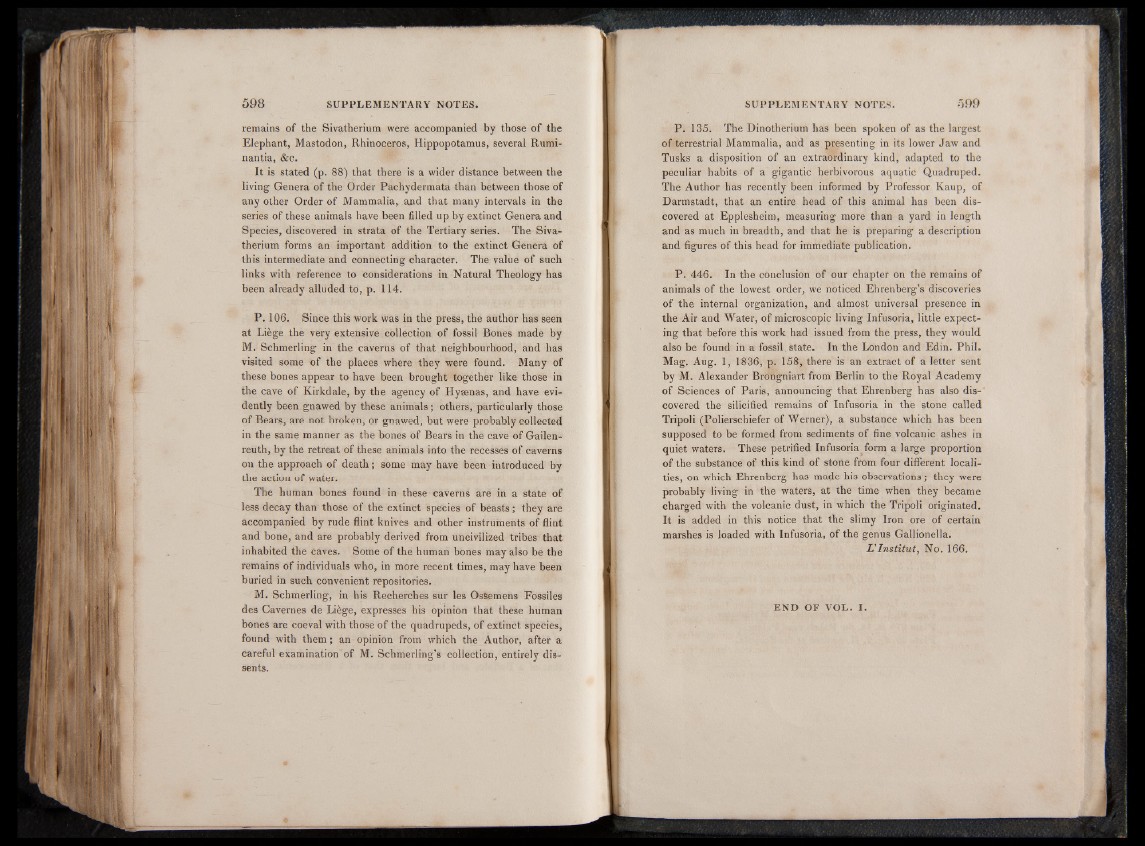
remains of the Sivatherium were accompanied by those of the
Elephant, Mastodon, Rhinoceros, Hippopotamus, several Rumi-
nantia, &c.
It is stated (p. 88) that there is a wider distance between the
living Genera of the Order Pachydermata than between those of
any other Order of Mammalia, and that many intervals in the
series of these animals have been filled up by extinct Genera and
Species, discovered in strata of the Tertiary series. The Sivatherium
forms an important addition to the extinct Genera of
this intermediate and connecting character. The value of such
links with reference to considerations in Natural Theology has
been already alluded to, p. 114.
P. 106. Since this work was in the press, the author has seen
at Liège the very extensive collection of fossil Bones made by
M. Schmerling in the caverns of that neighbourhood, and has
visited some of the places where they were found. Many of
these bones appear to have been brought together like those in
the cave of Kirkdale, by the agency of Hyænas, and have evidently
been gnawed by these animals ; others, particularly those
of Bears, are not broken, or gnawed, but were probably collected
in the same manner as the bones of Bears in the cave of Gailen-
reuth, by the retreat of these animals into the recesses of caverns
on the approach of death ; some may have been introduced by
the action of water.
The human bones found in these caverns are in a state of
less decay than those of the extinct species of beasts ; they are
accompanied by rude flint knives and other instruments of flint
and bone, and are probably derived from uncivilized tribes that
inhabited the caves. Some of the human bones may also be the
remains of individuals who, in more recent times, may have been
buried in such convenient repositories.
M. Schmerling, in his Recherches sur les OsSemens Fossiles
des Cavernes de Liège, expresses his opinion that these human
bones are coeval with those of the quadrupeds, of extinct species,
found with them ; an opinion from which the Author, after a
careful examination of M. Schmerling’s collection, entirely dissents.
P. 135. The Dinotherium has been spoken of as the largest
of terrestrial Mammalia, and as presenting in its lower Jaw and
Tusks a disposition of an extraordinary kind, adapted to the
peculiar habits of a gigantic herbivorous aquatic Quadruped.
The Author has recently been informed by Professor Kaup, of
Darmstadt, that an entire head of this animal has been discovered
at Epplesheim, measuring more than a yard in length
and as much in breadth, and that he is preparing a description
and figures of this head for immediate publication.
P. 446. In the conclusion of our chapter on the remains of
animals of the lowest order, we noticed Ehrenberg’s discoveries
of the internal organization, and almost universal presence in
the Air and Water, of microscopic living Infusoria, little expecting
that before this work had issued from the press, they would
also be found in a fossil state. In the London and Edin. Phil.
Mag, Aug. 1, 1836, p. 158, there is an extract of a letter sent
by M. Alexander Brongniart from Berlin to the Royal Academy
of Sciences of Paris, announcing that Ehrenberg has also discovered
the silicified remains of Infusoria in the stone called
Tripoli (Polierschiefer of Werner), a substance which has been
supposed to be formed from sediments of fine volcanic ashes in
quiet waters. These petrified Infusoria form a large proportion
of the substance of this kind of stone from four different localities,
on which Ehrenberg has made his observations; they were
probably living in the waters, at the time when they became
charged with the volcanic dust, in which the Tripoli originated.
It is added in this notice that the slimy Iron ore of certain
marshes is loaded with Infusoria, of the genus Gallionella.
L’Institut, No. 166.
END OF VOL. I.